Lately I’ve been having a lot of conversations around investment terms with searchers, as well as investors.
About 15 years ago, I interned at a search fund. And, over the last few years, I’ve started to invest in the asset class going direct as well as through funds of search funds.
Investing in search funds is a great way to scratch my entrepreneurial itch, extremely rewarding when a searcher finds success, and can be economically rewarding too.
This post is my attempt to share thoughts on self funded search economics in an effort to contribute to the search fund community, get feedback on my thinking from a wider audience, and of course meet more people who are doing searches/investing and may want to collaborate (please feel free to reach out!).
You can watch a video of me explaining this model here, and download the excel here:

Enterprise Value
The standard finance equation is enterprise value = debt + stock – cash. Enterprise value is how much the company itself is worth. Many times people confuse it with how much the stock is worth and find the “minus cash” part of this really confusing.
So, you can rearrange this equation to make it stock = enterprise value – debt + cash. Make more sense now?
Enterprise value is just how much you’re willing to pay for the company (future cash flows, intellectual property, etc), not the balance sheet (debt and cash).
Most investors and searchers think about the EBITDA multiple of a company on an enterprise value basis because they’ll be buying it on a cash free, debt free basis. It becomes second nature to think about EBITDA multiples and know where a given business should fall given scale, industry, etc.
However, I believe this second nature way of thinking of things can be a massive disadvantage to investors given the way EV and multiples are talked about in our community currently.
Sources of capital, the typical way to calculate enterprise value for self funded searchers
If you’ve ever looked at or put together a teaser for a self funded search deal, you will notice that the deal value is equal to the sum of the sources of capital minus deal fees and cash to the balance sheet.
As a simple example, if there is $4 mm of debt to fund the deal, $1 mm of equity, and $200k of deal fees, the enterprise value = $4 mm + $1 mm – 200k = $4.8 mm.
We’ll use slightly more complex numbers in our example: If a searcher is taking a $3.2 mm SBA loan, $850k seller note, putting in $120k themselves, getting $350k of equity from the seller, a $500k earnout, and $1.2 mm of equity financing minus $350k to the balance sheet and $250k of deal fees, then the enterprise value will be $5.62 mm.
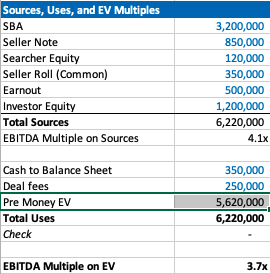
Our example company has $1.5 mm of EBITDA, so the EBITDA multiple is 3.7x. This is a pretty attractive acquisition multiple for a business that meets traditional search criteria (recurring revenues, fragmented competition, high gross margins, low customer concentration, etc).
If you’re seeing a search fund deal for the first time, the headline of “we’re buying a decent company for 3.7x, and replacing a tired owner with a hungry operator” is pretty exciting!
However, if you’re an investor, there is some nuance to this enterprise value number and the true EBITDA multiple you are investing in.
The trick with self funded enterprise value
The security that most self funded search investors get in a deal is participating preferred stock with a paid in kind dividend. This means when there’s an exit, you get your money back before any other equity holder, then get a certain percent of the business, and whatever dividend you’ve been owed in the interim accrues to your principle.
It’s a really favorable security for the investor, and one that is basically impossible to get in VC where straight preferred stock is much more common (no pun intended).
The key terms are what percent of common equity does this security convert into after the originally principal is paid back, and what is the dividend.
The share of common equity the investor group will get typically ranges from 10-50% of the total common stock. The dividend rate is usually 3-15%. The average I’m seeing now is around 30% and 10% for common and dividends respectively.
The strange this about the enterprise value quoted to investors in a teaser/CIM is that it doesn’t change as the percent of common changes, even though this has large implications for how much the common equity is worth and the value investors receive.
For example, I may get a teaser where the sources of investment – cash to balance sheet – deal fees = $3.7 mm for a $1 mm EBITDA company, which would imply a 3.7X EBITDA multiple. Let’s say the searcher is offering investors 30% of the common and a 10% dividend.
Let’s now say that the searcher is having a tough time raising capital and changes their terms to 35% of common and a 12% dividend. Does the effective enterprise value change for investors? I would argue yes, but I would be surprised to see it changed in the CIM/teaser.
This isn’t a knock on searchers or the search fund community. It’s just kind of how things are done, and I think this is mostly because it’s really hard to think about how the enterprise value has changed in this scenario.
However, the natural way of using EBITDA multiples to think about value for a business that is so common in PE/SMB can be extremely misleading for investors here. You may be thinking 3.7X for this type of business is a great deal! But, what if the security you’re buying gets 5% of the common?
If you’re in our world, you may counter this point by saying most searchers will also supply a projected IRR for investors in their CIM. However, IRR is extremely sensitive to growth rate, margin expansion, and terminal value. While the attractiveness of the security will be reflected, it can be greatly overshadowed by lofty expectations.
To get more clarity and have a slightly different mental model on the effective price investors are paying for this business, let’s go back to basics. Enterprise value should be debt + preferred stock + common stock – cash.
We know the values of each of these numbers, except the common. So, the main question here becomes: how much is the common equity worth?
Calculating value of common equity for self funded search funds
Equity value for most search fund deals = preferred equity from investors + the common equity set aside for the searcher and sometimes also advisors, board, seller.
We know that the preferred equity is investing a certain amount for a certain amount of common equity. The rub is that they are also getting a preference that they can take out before any common equity gets proceeds, and they are getting a dividend.
So, the exercise of valuing the common equity comes down to valuing the preference and dividend.
In my mind, there are three approaches:
- The discount rate method where you take the cash flows you’ll get in the future from the pref/dividends and discount them back at the discount rate of your choice. I am using 30% in my model which I believe accurately compensates investors for the risks they are taking in a small, highly leveraged investment run by an unproven operator. If you believe in efficient markets, this number also fits as it mirrors the historical equity returns as reported by the Stanford report, with a slight discount given this asset class has clearly generated excess returns relative to other assets on a risk adjusted basis, hence interest in these opportunities from an expanding universe of investors.
- The second method is to calculate how much money you’d get from your preference and dividends, taking into account that per the Stanford study around 75% of search funds will be able to pay these sums, and then discount these cash flows back at a rate more in line with public equities (7% in my model). This yields a much higher value to the preference/dividend combo, and therefore lowers the implied value of the common equity.
- The last method is to just say nope, there is no value to the preference and dividend. I need them and require them as an investor, but they are a deal breaker for me if they aren’t there, and therefore they don’t exist in my math. This of course makes no logical sense (you need them, but they also have no value?), but I’ve left it in as I think many investors probably actually think this way and it creates a nice upper bound on the enterprise value. Side note, as with obstinate sellers, jerk investors are usually best avoided.
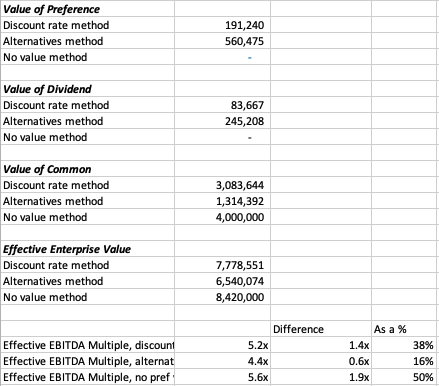
In our example, you can see a breakdown of the preference value, dividend value, and therefore common value and enterprise value for this deal.
In each case, the effective EBITDA multiple moves from 3.7x to something much higher (see the last 3 lines).
There are some simplifying assumptions in the model (no accruing dividend, all paid in last year), and some weird stuff that can happen (if you make the hold time long and the dividend greater than the 7% equity discount rate, the value of the dividend can get really big).
These flaws aside, I think this creates a nice framework to think through what the common is actually worth at close, and therefore what enterprise value investors will be paying in actuality.
It’s worth noting that the whole point of this is to benchmark the value you’re getting relative to market transactions in order to understand where you want to deploy your capital.
This creates a method to translate cash flow or EBITDA multiples of other opportunities on an apples to apples basis (if only there were a magical way to translate the risk associated with each as well!).
Another note, we could calculate the value of the common to be what this asset would trade at market today in a well run auction process minus any obligations (debt, preference, seller financing). However, I think that understates the option value inherent in this equity, a value that is only realized when a new manager takes over with more energy and know how.
There is a finance nerd rational for this. If you plot the value of equity in a leveraged company on a chart, it mirrors the payout of a call option. In both cases, the value of the security increases at a certain inflection point: when the value of equity rises above the strike price in an option, and when the enterprise value of a company rises above the debt level in a levered company.
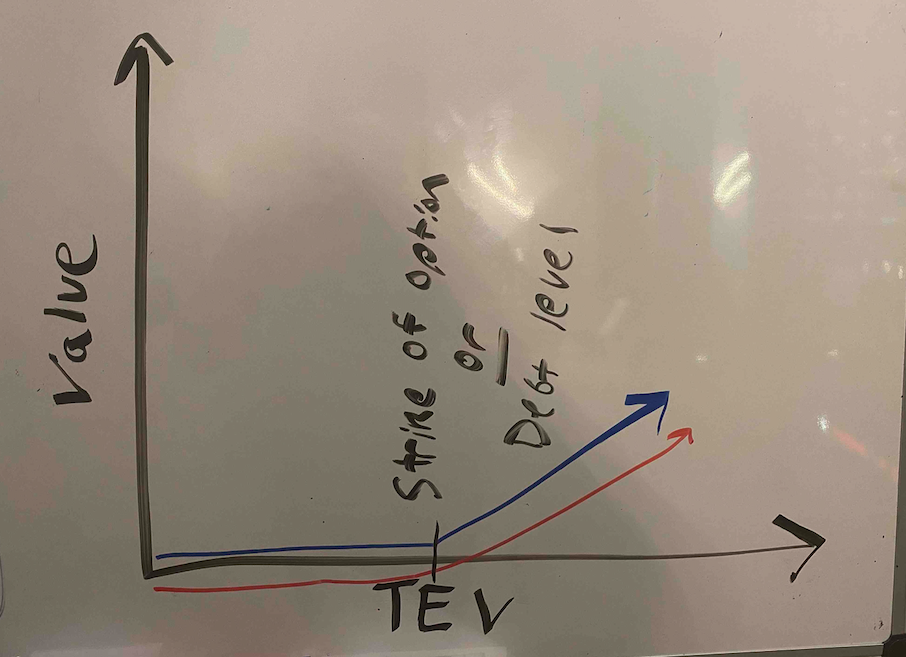
The common equity of a highly levered company can therefore be valued by a similar methodology as the call option: Black Scholes. If you remember back to finance class, increasing volatility will increase the value of an option.
In the search fund case, we’ve (hopefully) increased the (upside) volatility and therefore create more value than simply selling the company today.
A few more thoughts on investor economics
There are a few other ways to think about the economics you get as an investor to best understand if this is the deal for you.
First, you may want to think about how much your investment will be worth day 1. The key lever in this model is what discount this company is being bought for relative to fair market value. For example, the searcher may have proprietary sourced a great company and is buying it for 25% below what it would trade at in a brokered auction.
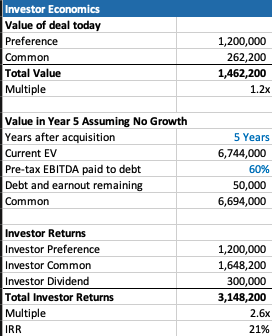
This is very much a “margin of safety” philosophy on things. Same with the calculation on how much you’ll receive in year 5 (after QSBS hits) assuming no growth in the business.
The only problem with each of these calculations is that they never play out in practice. Most companies don’t just stay the same, you’re either in a rising tide or you’re in trouble. And, you’re almost never going to sell in year 1, and definitely not for a slight premium to what it was bought for.
However, if your investment is worth 30% higher day one, and you can make a 20% IRR assuming nothing too crazy happens either way in the business, that’s not a bad place to start. Add in a strong searcher, decent market, some luck, and you’re off to the races.
Thoughts on searcher economics
A lot of this post has considered things from the investor perspective as my main quandary was related to how to create an EBITDA multiple that made sense for investors.
However, the point of this post is not to say searchers are misrepresenting or being unrealistic with their terms. In fact, I think it’s quite logical that self funded searchers capture the massive economic value that they do.
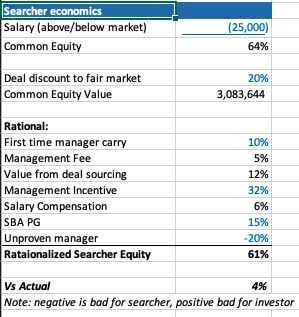
There are many reasons why self funded searchers deserve the lion share of the common equity.
First, they are providing a nice service of giving investors a positive expected value home to park their money with much lower correlation to the market than other asset classes ($1 mm EBITDA companies don’t see lots of multiple contraction/expansion throughout cycles).
Most money managers that fit that criteria are taking a 2/20, of course they also usually have a track record. So, I’ve used a 10% carry in my model, but stuck to 2% annual management fee.
The searcher spent a lot of time, and probably money, finding this company. That’s a lot of value, especially if it’s a below market price. They should be able to capture a lot of the value in finding a below market deal.
The searcher may be taking a below market salary, and needs to get comped like any CEO, with stock options. In my example model I have $1 mm of stock vesting over the hold period, as well as extra comp for taking a below market salary.
Searchers are also usually putting their financial standing at risk by taking a personal guarantee on the bank/SBA loan. This is really tough to put a number on, as is the last line in my framework where searchers are dinged for lack of experience. Like any good model, you need a few lines that you can fudge to make the math work 🙂
What you do think?
I’m shocked that I wrote all this. I was going to type a few paragraphs and a quick excel. However, putting this to paper has been a great exercise for me to sharpen my thinking.
Now I’d like you to help me further. Where do you think this should be changed in this framework? How do you think about things from the investor and/or searcher side?
Feel free to shoot me a note if you have thoughts (even just to tell me I’m being way too academic with this, which I actually agree with).
Lastly, a post like this is really a trap I’m putting on the internet to catch any like minded people in so that we can figure out ways to collaborate now or in the future. So, at the very least, connect with me on LinkedIn 🙂

Very nice post. I just stumbled upon your blog and wanted to say that I have really enjoyed
browsing your blog posts. In any case I will be subscribing to your feed
and I hope you write again soon!
Greetings! Very helpful advice within this post! It’s the
little changes which will make the most significant changes.
Thanks a lot for sharing!
What you wrote made a bunch of sense. But, what about this?
suppose you added a little content? I mean, I don’t want to tell you
how to run your blog, but what if you added a title that grabbed
people’s attention? I mean Thoughts on Search Fund Economics – Phil Strazzulla's Blog is kinda boring.
You ought to look at Yahoo’s home page and note how they create post titles to grab people to click.
You might add a video or a related pic or two to grab readers interested about what you’ve got to say.
In my opinion, it could make your blog a little livelier.
This post is invaluable. How can I find out more?
It’s a pity you don’t have a donate button! I’d
definitely donate to this fantastic blog! I suppose for now i’ll settle for book-marking and
adding your RSS feed to my Google account. I look forward to fresh updates and
will talk about this site with my Facebook group. Talk soon!
Wow, marvelous weblog layout! How lengthy have you ever been blogging
for? you made running a blog glance easy. The entire glance of your
web site is excellent, as smartly as the content!
Amazing issues here. I’m very satisfied to see your article.
Thank you a lot and I am having a look ahead to touch you.
Will you please drop me a mail?
Hmm is anyone else experiencing problems with the
pictures on this blog loading? I’m trying to determine if
its a problem on my end or if it’s the blog. Any feedback would be greatly appreciated.
This excellent website truly has all of the information and facts I needed
concerning this subject and didn’t know who to ask.
Hello would you mind stating which blog platform you’re working with?
I’m going to start my own blog soon but I’m having a difficult time selecting between BlogEngine/Wordpress/B2evolution and Drupal.
The reason I ask is because your layout seems different then most blogs and I’m looking for something unique.
P.S Apologies for being off-topic but I had to ask!
Currently it appears like Expression Engine is the
best blogging platform available right now. (from what I’ve read) Is that
what you’re using on your blog?
I have been surfing on-line greater than 3 hours lately, yet I by
no means found any attention-grabbing article like yours.
It’s pretty worth enough for me. In my opinion, if all
site owners and bloggers made good content material as you did, the web will be much more useful than ever before.
I don’t even understand how I finished up right
here, but I believed this post used to be good. I don’t realize who you might be but certainly you’re going
to a well-known blogger for those who aren’t already. Cheers!
Hello, its nice piece of writing about media print, we all be aware of media is a great source of data.
Hi there! This is my first visit to your blog!
We are a collection of volunteers and starting a new
initiative in a community in the same niche. Your blog provided us beneficial information to work on. You have done a wonderful job!
Greetings I am so glad I found your webpage, I really found you by
accident, while I was looking on Bing for something else, Nonetheless I am here now and would
just like to say cheers for a tremendous post and
a all round thrilling blog (I also love the theme/design), I don’t have time to browse it all at the minute but
I have saved it and also included your RSS feeds, so when I have time I will be back to
read a great deal more, Please do keep up the awesome work.
I love your blog.. very nice colors & theme. Did you create this website yourself
or did you hire someone to do it for you? Plz answer back
as I’m looking to create my own blog and would like to know where u
got this from. thank you
In fact when someone doesn’t know after that its up to other users that they will help, so here it occurs.
This article will assist the internet visitors for setting up new blog or even a blog from start to end.
Hi friends, how is the whole thing, and what you want to say regarding this piece of writing, in my view its in fact amazing designed for me.
It is the best time to make a few plans for the
longer term and it is time to be happy. I have read
this put up and if I may just I wish to recommend you
few fascinating things or advice. Perhaps you could write subsequent
articles referring to this article. I want to read more
issues about it!
It’s very easy to find out any topic on net as compared to textbooks,
as I found this piece of writing at this web site.
First of all I want to say superb blog! I had a quick question that
I’d like to ask if you do not mind. I was curious to know how you center yourself and clear your mind before writing.
I have had difficulty clearing my mind in getting my ideas out.
I do take pleasure in writing but it just seems like the first 10 to 15 minutes tend to be lost just trying to figure
out how to begin. Any ideas or hints? Many thanks!
Awesome! Its in fact amazing paragraph, I have got much
clear idea about from this piece of writing.
What a data of un-ambiguity and preserveness of precious knowledge about unexpected emotions.
Hello to every one, the contents existing at this
web page are genuinely amazing for people experience, well, keep up the nice
work fellows.
Hello! Someone in my Myspace group shared this website with us so I
came to check it out. I’m definitely loving the information. I’m bookmarking
and will be tweeting this to my followers! Wonderful blog and wonderful design.
Undeniably believe that which you said. Your favorite reason appeared to be on the
web the simplest thing to be aware of. I say to you, I certainly get annoyed while people think about worries that
they plainly do not know about. You managed to hit the nail upon the
top and also defined out the whole thing without having side effect , people can take a signal.
Will likely be back to get more. Thanks
Hi there, after reading this remarkable paragraph i am also happy to share my
experience here with friends.
Excellent blog here! Also your web site lots up fast!
What web host are you the use of? Can I get your associate hyperlink in your host?
I wish my website loaded up as fast as yours lol
Hurrah, that’s what I was exploring for, what a data! present here
at this webpage, thanks admin of this site.
I think the admin of this web site is in fact working hard
in support of his site, because here every information is
quality based material.
I have to thank you for the efforts you have put in penning this
site. I am hoping to see the same high-grade blog posts from you in the future as well.
In fact, your creative writing abilities has inspired me to get
my own, personal blog now 😉
Hi there would you mind letting me know which web host you’re using?
I’ve loaded your blog in 3 different browsers and I must say this blog
loads a lot faster then most. Can you recommend a good hosting provider at a honest price?
Cheers, I appreciate it!
This website was… how do you say it? Relevant!!
Finally I’ve found something that helped me. Cheers!
Asking questions are genuinely nice thing if you are not understanding something
fully, but this post provides good understanding yet.
I was able to find good advice from your content.
Hello there, You’ve done a great job. I will certainly digg it and personally suggest to my friends.
I am confident they’ll be benefited from this web site.
I will right away clutch your rss as I can not in finding your email subscription hyperlink
or newsletter service. Do you’ve any? Please let me
recognise in order that I may just subscribe. Thanks.
Hello, I enjoy reading all of your article post. I wanted to write
a little comment to support you.
This website was… how do you say it? Relevant!!
Finally I’ve found something that helped me. Thanks!
Hello to every one, since I am genuinely keen of
reading this blog’s post to be updated regularly.
It consists of fastidious stuff.
I’m really impressed with your writing skills and also with
the format for your blog. Is that this a paid topic or did
you customize it your self? Anyway stay up the nice high quality writing, it is rare to
peer a nice weblog like this one nowadays..
Hello, I check your blogs regularly. Your story-telling style is awesome, keep doing what you’re doing!
If you want to grow your experience just keep visiting this website and be
updated with the most recent news posted here.
I think what you published made a lot of sense.
However, consider this, what if you added a
little information? I ain’t suggesting your information isn’t solid., but what
if you added a headline that grabbed people’s attention? I mean Thoughts on Search Fund Economics –
Phil Strazzulla's Blog is a little plain. You could peek at Yahoo’s home page and see how they create article headlines to get people interested.
You might add a related video or a related picture or
two to grab people excited about everything’ve written. Just my opinion, it
would make your website a little bit more interesting.
Thanks for sharing your info. I really appreciate your
efforts and I will be waiting for your further write ups thanks
once again.
I couldn’t refrain from commenting. Well written!
Very shortly this site will be famous amid all blog visitors, due to it’s nice articles or reviews
A person essentially assist to make seriously articles I might state.
This is the first time I frequented your website page and thus far?
I amazed with the analysis you made to create this actual submit
incredible. Great task!